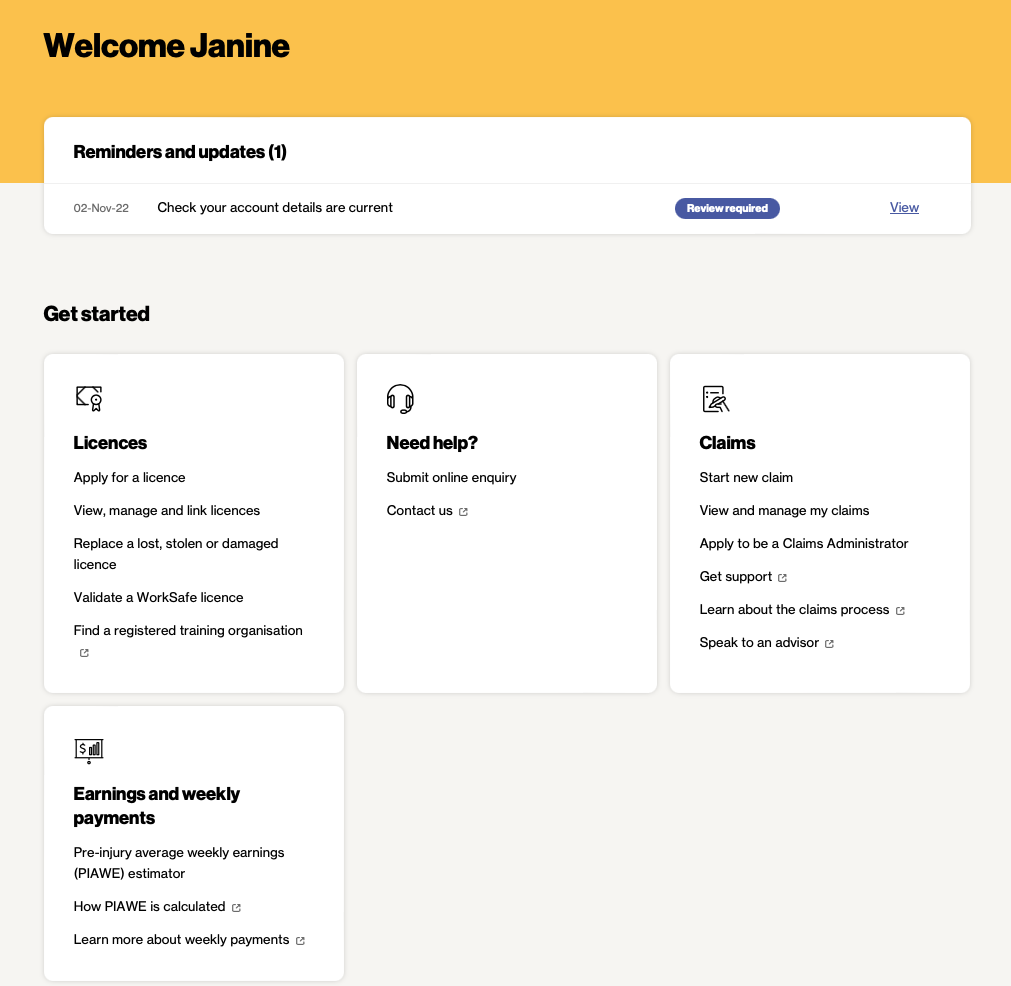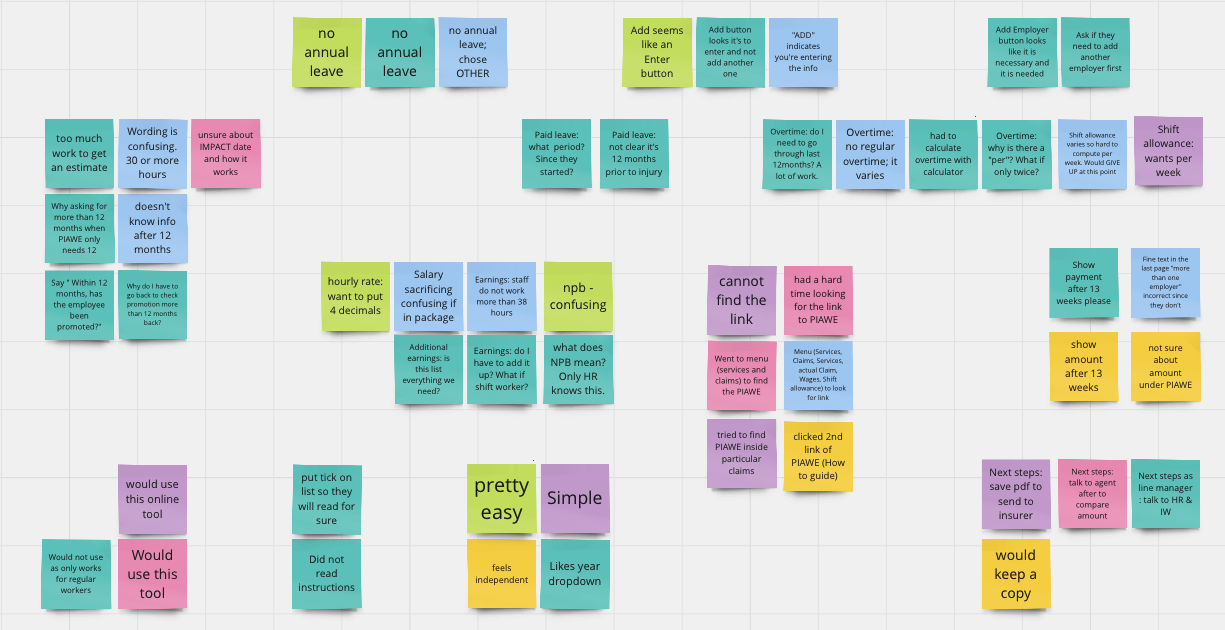
WorkSafe

WorkSafe Victoria is a government agency that helps injured Australians get back to work. I was part of the Claims and Recovery team and the broader design team. My responsibilities included: research, design, test, build on the design system, write design briefs and test plans, present to the broader business, conduct workshops, coordinate with other teams with regards to testing end to end. I worked on digitising the Claims form for both the injured workers and the employers, create a new payment estimator inside the platform, and create a new insurance registration. I was the Senior Product Designer and worked closely with the Product Owner, Business Analyst, Subject Matter Expert, Content Writer, Developers, QA testers, Change Analyst, and the Design team.
In this case study, I will delve into Pre-injury Average Weekly Estimate (PIAWE) estimator we created as a tool to help users to calculate their comensation due to their injury. Currently, only the WorkSafe agents have access to a PIAWE calculator. So if anyone wants to know how much they could get, they need to contact an agent and they calculate it for you. This new tool empowers the users to get an estimate and see if filing a claim is worth it. This tool aims to guide, inform and give peace of mind. The challenge was to simplify something very complicated.
The main persona of the user of the PIAWE estimator is an Australian resident worker, aged 40, employed by an organisation with 20-50 employees, with an annual salary of 70-120K.
Phase 1: Research
I conducted Business stakeholder meetings and workshops to understand their WHY. I needed to understand what the business goal for this project was and what our projected timeline was so I can plan appropriately. The business goals include: lightening the load for the agents so they can help more injured workers and helping any injured worker in their submission of an online claim form. Simultaneous to these meetings, I put up the whole calculator (a current tool that agents use) on our wall to dissect and try to think of the best way to simplify a complicated product. As this was a new tool we were introducing, I used other people in the business to do initial testings while sketching ideas. Everyone is a worker so everyone is a user. A comparative analysis of different online calculators (to compare features and flows) was completed and analysed. I created user flows and user journeys to visualise the proposed complete journey. There were a lot of backend equations and information to digest that was all part of the research. I needed to understand how the equation is completed to be able to simplify it. Due to company privacy, some images of the process cannot be displayed and some information in the photo displayed have been blocked out.

Some details have been blocked out for company privacy

Stakeholder journey
Phase 2: Design
Designing the PIAWE estimator proved to be fun and challenging as it is complicated and unknown territory for most people. We went through roughly 6 iterations before we got to a final stage. It was hard to strike a balance between simple and comprehensive. We built everything on a new system, Velocity, so there were limitations to what components we can build without going against the current WorkSafe Design System in place. Presenting to the whole business allowed me to get feedback on what can be improved on.
Some feedbacks were: expanding the title PIAWE in the tile so it’s clear what it is, putting additional tool tips to terms that might be confusing to users, visualising the summary in a tabular form to make it easier to view and print.
Design was also based on the insights from the Claims form user testing conducted. Some key insights from that testing:
Users do not read the whole Getting Started page line per line
There are terms that are unclear
Some questions are repeating in different steps and are confusing
They do not have all the information ready on hand
I made sure the Getting Started page for the PIAWE estimator was succinct yet complete. I separated the list of things needed so users have less chances of missing it and creating a poor experience for themselves. I eliminated repeating questions and reworded jargons to be more understandable. I divided the questions into smaller pages so it’s not overwhelming to the users. I designed most questions to start with a simple yes or no so easier and faster thinking is involved. Everything was strategised to be more seamless and to align with the wording and flow of other department’s projects that are connected to the PIAWE estimator.
This new tool had to be integrated within the WorkSafe website and doing so entailed separate design work. The main concern being this is a new tool we are offering the public and there is no space for it in the current layout. Working alongside the website design team, we held workshops on how to properly incorporate the PIAWE estimator. It did not quite fit anywhere; therefore, we created a new tile to house everything users will need to know regarding this tool. I designed the PIAWE estimator tile that included the wording of the titles, icon, and order of information that is presented. Since this was a tool that will be open to the public, the goal was to make sure it was easy to find on the home page and getting an estimate was quick.

WorkSafe homepage with PIAWE estimator tile
Phase 3: Testing
End to end testing before go live was fulfilled and included the licensing, premiums and comms team. A design brief was written that listed down the plan on how testing will be conducted after the pilot. It has been divided into 3 parts of the journey: from login/sign up, filling up all the input fields, and getting a PIAWE estimate. This brief included survey plans that were finalised with the change analyst. The surveys tackled more general temperature check and if they allowed, we contacted the users directly to get more details. Insights from testing were analysed and recommendations were put in the backlog for the next release.

Affinity map of PIAWE user testing insights
The aim of testing was to see if the users understood what the product was for, what the required fields meant, if they had a hard time finding the required information, and if the estimator was able to give them an estimate they feel confident with.
I worked alongside Vision Australia with regards to accessibility testing to ensure we comply with WCAG 2.1 AA standards. All insights have been prioritised, applied, or put in the backlog for next release.
Next Steps
Release 1 has 25 businesses using the PIAWE estimator and Claims portal, with an uptake of 96 estimates within the first month of release. The plan for release 2 is to expand the estimator and Claims portal to be used by every business in the WorkSafe scheme. There are challenges with regards to such a big expansion. We need to take into consideration the system’s capability, if we need to store anything as reference when they speak to their respective agents, any iterations needed to improve the product for proper use of a much bigger user group. There is also some pushback from unions to use digital platforms so that will be another challenge for the team.
